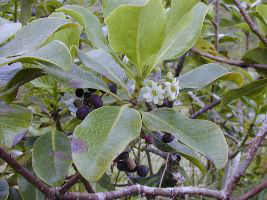The happy face spider (named for the bright patterns on its abdomen) makes its home on the undersides of the leaves of the Hawai'i holly.
Photo Credit: © Forest and Kim Starr via Wikimedia Commons.
Ilex anomala
Common Name: Hawai'i holly
Plant Functional Group: Evergreen broadleaf
Class > Order > Family: Magnoliopsida > Aquifoliales > Aquifoliaceae
